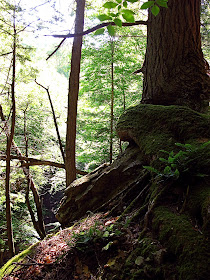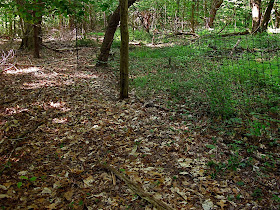While staying in Mt. Kisco this week, I had a chance to visit the Mianus River Gorge Preserve near the neighboring town of Bedford, NY. This preserve, founded over 50 years ago as The Nature Conservancy's first land project, contains over 760 acres of forest and wetlands along the Mianus River and includes a rare old-growth hemlock forest, with some trees over 400 years old. The privately owned preserve offers over 3.5 miles of trails, which are open to the public. Here's a section of the trail that passes close to the river. I was mighty glad for that deep shade and cooling water today, as the temperature climbed to the low 90s.

And here's one of those big old hemlocks. Because it stands at the top of the gorge where it has had access to abundant sunlight, this tree grew very tall, compared to some of the ancient trees in the deep forest whose small size belies their great age.
You can see how the roots of that tree have wrapped themselves around the rock and held on tight for hundreds of years. You can also see how steeply the gorge falls off, creating a landscape impossible to lumber and thus preserving these trees from the axe.
I visited this preserve a year ago, when I found a roiling mass of beautiful millipedes. My naturalist friend Ellen Rathbone later helped me locate a millipede expert who thinks that this might be a species for which no authentic specimen from New York state exists (Pleuroloma flavipes Rafinesque, 1820), and would I please send him a male specimen? Well, I hadn't collected one last year, so this year I determined to bring one home with me. But how do you tell the males from the females? And where the heck were they this year? Not where I found them last year, alas. After searching for some time, I despaired of finding them again and probably wouldn't have if I hadn't been a naughty hiker and stepped off the trail to examine some animal footprints in the soft mud by the river. And there they were, another roiling mass. They seem to really like mud.
Here's a closer picture of one, scooting away as fast as his multitude of legs would carry him. (Is it a him? How should I know?)
I grabbed him to try to keep him from disappearing, and he coiled up and pooped out a wet mess of muddy goo. Eeew!

Anyway, I popped this one and a couple more from different locations into a ziploc bag to send off to this millipede expert. I personally think these millipedes look more like the species Borania stricta (yes, I browsed the web for millipede images), but perhaps I will soon find out.
There were very few flowers growing in the shady woods, but I did find this pretty little clump of bright orange mushrooms.

Actually, there are very few native flowers growing anywhere in Westchester County, thanks to the overbrowsing by too many deer. Skunk Cabbage and Poison Ivy were about the only natives I could find among the alien invaders Oriental Bittersweet, Japanese Barberry, Garlic Mustard, and Multiflora Rose. The folks at this preserve are trying to do something about that, as this sign attests.
Here you can see the difference between what grows inside the fence, and what doesn't grow outside of it.
It was back at my daughter's home in Mt. Kisco that I found these two native wildflowers. But not in her well-tended gardens. No, they were growing in the sandy, stony soil next to the walk where not much else will grow and where her gardeners are sure to pull them out as untidy weeds. The first is Venus's Looking Glass. When it blooms it will have very pretty blue flowers, but the star-shaped buds in the axils of the scalloped leaves have their own kind of charm, don't you think?
And this, I believe, is Carolina Cranesbill, a tiny-flowered geranium that yes, I confess, looks pretty weedy. But hey, it's a native American wildflower, and a new one for my life list. So hurray!








I love those old growth trees. Can't to hear more about the millipedes.
ReplyDeleteHi Jackie,
ReplyDeleteI chose to comment on this posting because I just love the trees. You have wonderful photos, so many close-ups. I had not realized that the multi-flora rose was invasive.
It was great seeing you yesterday at my mother's art reception. She seemed very pleased with how it all went.
Here is my blog address:
http://nooksandvales.blogspot.com/
--Virginia